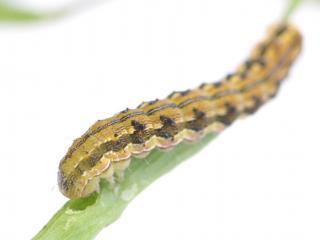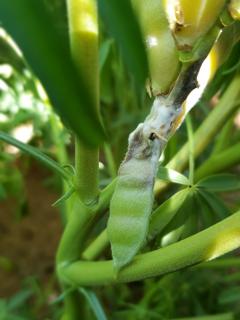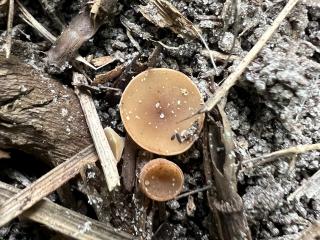Diamondback moth numbers are low, but growers are reminded to monitor with warming temperatures
- Geraldton
- Northam
- Mukinbudin
- Scaddan
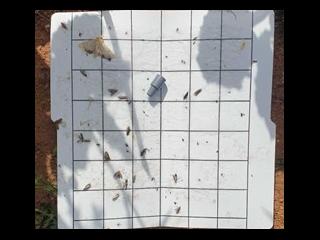
Low numbers of diamondback moth (DBM) have been detected in canola focus crops across the grainbelt as part of the Grains Research and Development Corporation (GRDC) DBM surveillance program.
The shire of Northam had the highest number of DBM moths captured in pheromone-baited traps over the last month with 46 moths, followed by Scaddan with 43, Mukinbudin with 22 and Geraldton with 18. In most traps, fewer than 10 moths were captured in a month. These low numbers differ from the same period last year, when the average number of moths per trap per month across the grainbelt area was 98 in July and 177 in August 2022. Notably higher numbers were captured in localised parts of the eastern grainbelt during August, which resulted in larvae increasing to above threshold levels fairly early and requiring spraying.

The DBM pheromone trap program is being conducted to gather data to better understand the drivers of DBM outbreaks in WA. Additionally, it provides an early indication of potential larvae build-up following increases in moth numbers detected. This early warning allows growers and agronomists to target their efforts in sweep netting crops, which is laborious and difficult in tall crops.

The DBM surveillance program is part of a GRDC-funded project and conducted by Department of Primary Industries and Regional Development (DPIRD) staff along with grower groups (Mingenew Irwin Group, West Midlands Group, Facey Group and Liebe Group) and South East Agronomy Research (SEAR) based at Esperance. Widespread surveillance occurs fortnightly throughout the season in 46 focus crops located across the grainbelt. Pheromone-baited delta traps are used to monitor DBM and sweep netting is undertaken to monitor larvae. The surveillance team will continue to provide regular updates to growers and consultants throughout the season via the PestFacts WA eNewsletter.
Diamondback moth caterpillars
- Mingenew
- Northam
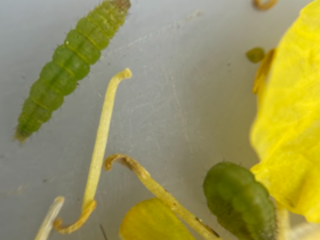
DBM caterpillars are usually pale yellowish green and tapered at each end of their body and grow to about 10 mm long. They often wriggle rapidly when disturbed and will hang on a silken thread. For more information, refer to DPIRD’s diagnosing diamondback moth page.
DBM larvae have not been detected at canola focus crops in the past fortnight apart from a single caterpillar at a Mingenew monitoring site, which confirms that low moth numbers during June and July have resulted in very low larvae numbers overall.
In July, Research Scientist Amber Balfour-Cunningham (DPIRD) reported below threshold numbers of larvae in sweeps of unsprayed early flowering canola at a Northam DPIRD field trial site. There have been no other reports into DPIRD regarding DBM larvae this season.
Monitoring and management
Despite low numbers of DBM being found so far this season, growers and consultants should begin their monitoring soon by doing at least four lots of ten sweeps with an insect net at various locations in each canola crop. Monitoring may assist with foreseeing possible damaging populations in spring when DBM activity usually ramps up.
DPIRD's Seasonal Climate Outlook report is predicting high chances of warmer temperatures and reduced rainfall for the August to October period. Canola plants are more vulnerable to caterpillar damage when they are stressed due to dry conditions and when they are closer to flowering.
If you are sweep netting canola crops for DBM caterpillars please use the PestFacts WA Reporter app to report your findings. It will help DPIRD’s DBM surveillance project team to determine how well the pheromone traps have worked in predicting outbreak risk and trigger crop protection programs before economic damage occurs.
When making the decision of whether to apply an insecticide, the DBM thresholds for flowering canola are:
- Early to mid flowering (no moisture stress) - 50 caterpillars or more per 10 sweeps
- Mid to late flowering (no moisture stress) - 100 or more caterpillars per 10 sweeps.
Some other helpful tips to consider when sweep netting crops are:
- A high proportion of small grubs (less than 3 mm) in a sample often indicates that numbers will increase further.
- Regular assessments of the number of grubs in the crop are required. This is because the numbers can fluctuate and are just as likely to decrease as they are to increase at any stage throughout the growing season. Grub numbers may reduce in cool, wet and windy conditions or fine and mild weather.
- When checking crops with a sweep net, be mindful that small native budworm caterpillars can easily be confused with DBM caterpillars in canola crops. Native budworm caterpillars are far more damaging as they grow to larger sizes (up to 40mm long) and will chew into the pods.
New product registered for diamondback moth in canola
Growers and agronomists should be aware that the active ingredient cyantraniliprole is now registered for use on DBM in canola.
Pesticide options for the control of DBM can be found in DPIRD’s 2023 Winter Spring Insecticide Guide.
More information
For more DBM information refer to:
- DPIRD’s Diagnosing diamondback moth page
- GRDC's Diamondback moth fact sheet
- GRDC’s Managing diamondback moth video.
For more information contact Research Scientist Svetlana Micic in Albany on +61 (0)8 9892 8591 or Technical Officer Alan Lord in South Perth on +61 (0)8 9368 3758.
Article authors: Bec Severtson (DPIRD Northam) and Christiaan Valentine (DPIRD Northam).
Native budworm caterpillars are appearing in the northern region
- Yallabatharra
- Nolba
- Ogilvie
Following on from the significant numbers of native budworm moths detected in moth traps in the northern agricultural region in late June and early July, caterpillars are now being found in some crops in the area.
In the past week Research Scientist Andrew Phillips (DPIRD) reported finding around 21 native budworm larvae per 10 sweeps in a canola crop near Yallabatharra. He also netted an average of one larva per 10 sweeps in a canola crop near Nolba.
Interestingly, no native budworm larvae have been reported from canola crops near Moonyoonooka, Wicherina and Marrah where large numbers of moths were reported in late June and early July.
This week, Nic McKenna (Planfarm) reported that native budworm caterpillars were damaging the flag leaves of wheat at Ogilvie. Based on a recently completed GRDC-funded project, economic losses are estimated at $1.71 per hectare, when there are 5 larvae per square metre (approx. 50 larvae per 10 sweeps), or $2.75 per hectare loss when there are 10 larvae per square metre (approx. 100 larvae per 10 sweeps). This is based on a $360 per tonne wheat price and anticipated yield of 2 tonnes per hectare. For more information, refer to the GRDC Groundcover article 'Is native budworm targeting wheat crops?'.
Large numbers of native budworm moths do not always equate to large numbers of larvae. Only a small proportion of eggs laid by native budworm moths survive to the damaging large caterpillar stage. Eggs and very small larvae can be dislodged and will die after heavy rain or wind. Predators, disease and parasites also affect numbers in some seasons.
Native budworm moth trapping update
This week, the largest numbers of native budworm moths caught in pheromone traps were reported at Southern Cross (48 moths), Maya (32), Kellerberrin N (32), Cunderdin N (25) and Dowerin (20).
Over a 21-day period, moth counts reported from the Geraldton region were 138 moths in Yallabatharra, 41 in Mooyoonooka, 33 in Wicherina and 12 in Marrah. This is significantly less than in June and early July.
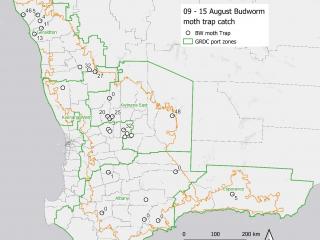
A mapped view of the native budworm trap captures is available at Cesar Australia’s MothTrapVisWA page. Users need to select the desired trapping date range.
More results of this week's trappings are available for viewing at the department’s native budworm moth numbers 2023 page.
Pesticide options for the control of native budworm can be found in DPIRD’s 2023 Winter Spring Insecticide Guide.
Growers and agronomists should be aware that the active ingredient cyantraniliprole is now registered for use on native budworm and diamondback moth on canola.
Detailed information on this pest can be found at the department’s management and economic thresholds for native budworm.
To read about earlier native budworm activity this season, refer to the 2023 PestFacts WA Issue 9 article, 'native budworm are active early'.
For more information, contact Technical Officer Alan Lord in South Perth on +61 (08) 9368 3758 or +61 409 689 468.
Article authors: Alan Lord (DPIRD South Perth) and Bec Severtson (DPIRD Northam).
Turnip yellows virus is spreading in canola in Kwinana West and Albany port zones
Surveillance update
-
Kwinana West port zone
-
Albany port zone
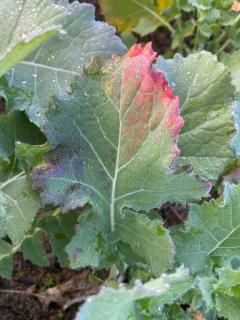
After a significant surge in green peach aphid (GPA) movement and colonization in canola crops in the Kwinana West and Albany port zones recently, there has been a considerable spread of Turnip yellows virus (TuYV). This virus is being transmitted by GPAs and is now reaching significant levels. In certain cases, it has caused visible symptoms, as shown in the image above and below.
This update has been provided by DPIRD's ongoing monitoring of GPA activity at sites in the Kwinana West, Albany and Esperance port zones.
Monitoring and management
Early sown crops that have already flowered are less vulnerable to this virus. However, canola crops that were sown late and are only just reaching flowering are at risk for yield losses due to TuYV infection. TuYV symptoms include leaves purpling, reddening or yellowing and plant stunting. TuYV can still cause yield loss without producing obvious symptoms.
If you suspect TuYV infection in your crop, please contact DPIRD Plant Virologist Ben Congdon on +61 (0)8 9368 34 99 to organize free virus testing.
As day length and daytime temperatures increase over the coming months, it is expected that aphids will continue to build up in crops across the WA grainbelt.
For canola aphid insecticide recommendations, refer to DPIRD’s 2023 winter spring insecticide guide.
Further information
To read about earlier aphid and TuYV activity this season, refer to the previous 2023 PestFacts WA articles:
- Issue 10 Turnips yellows virus detected in flying green peach aphids and in canola
- Issue 7 Green peach aphid and turnip yellows virus update
- Issue 6 Green peach aphid alert
- Issue 5 Early season aphid and virus risk in cereals and canola.
For more aphid and virus information, refer to DPIRD’s:
- Aphid management in canola crops page.
- Turnip yellows virus early warning system page
- Turnip yellows virus in canola: diagnosis and management page.
For further information contact Research Scientist Benjamin Congdon, South Perth on +61 (0)8 9368 3499.
Article authors: Benjamin Congdon (DPIRD South Perth) and Cindy Webster (DPIRD Narrogin).
Sclerotinia stem rot update
- Geraldton
- Northam
- Kojonup
- Gibson
- Wittenoom Hills
- Neridup
Apothecia have been easy to find under May sown lupins at Geraldton since significant rainfall last week. This week the first symptoms of canopy sclerotinia have been observed on lupin pods on scattered plants.
Apothecia have been observed for the first time this year in the sclerotia depot at Kojonup in the past week. Apothecia continue to be found in the sclerotia depots at Northam and Gibson.
Quenten Knight (Agronomy Focus) also recently found apothecia under wheat crops near Wittenoom Hills and Neridup. Both paddocks had been sown to canola in 2022.
These apothecia reports are a warning that the moist weather in recent weeks has suited the commencement of the sclerotinia disease lifecycle in those areas. Canola petal testing at Northam has confirmed that crops in this area have been infected, and have the potential to develop sclerotinia stem rot if seasonal conditions are favourable for the disease.
Growers in areas with a history of sclerotinia are reminded to monitor their lupin and canola crops for sclerotinia stem rot infection. Growers are also encouraged to consider sclerotinia management when crops are close to or at flowering, especially if future weather conditions are conducive (regular rainfall and high humidity with temperatures less than 25°C).
A new GRDC factsheet based on results of DPIRD research has been recently published to help growers identify which of their lupin crops may be at risk of sclerotinia infection. Crops that reach canopy closure early in the season and have dense canopies are at higher risk of developing sclerotinia due to canopy humidity favouring the disease. For more information, refer to the GRDC fact sheet lupin sclerotinia disease risk assessment guide.
The SclerotiniaCM decision support tool is available for canola growers to use during flowering. The tool can help determine the likely economic returns from applying fungicide at a specific time during flowering for the control of sclerotinia stem rot. For more information, refer to DPIRD’s SclerotiniaCM decision support tool page.
Further information on sclerotinia symptoms, fungicide management and identification of canola bloom stages was covered in a previous article in 2023 PestFacts WA Issue 10 article sclerotinia stem rot.
For more information on sclerotinia in lupins, contact plant pathologists Ciara Beard in Geraldton on +61 (0)8 9956 8504 or Geoff Thomas in South Perth on +61 (0)8 9368 3262.
For more information on Sclerotinia in canola, contact plant pathologists Ciara Beard in Geraldton on +61 (0)8 9956 8504, Andrea Hills in Esperance on +61 (0)8 9083 1144 or Jean Galloway in Northam +61 (0)8 6690 2172.
Article authors: Ciara Beard (DPIRD Geraldton).
Article input: Jean Galloway (DPIRD Northam).

